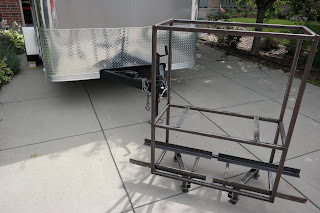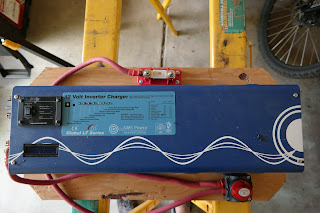The standard 7 Pin towing hookup does have a hot lead for charging an RV battery, but that is really only for keeping a small RV battery charged while driving - not for charging a high output system like this one. The hot lead on a towing vehicle has a 12AWG wire and a 30 amp fuse. This just isn't designed to handle the load of the large batteries I have, and the small wire size limits the current and takes too long to charge large batteries.
Another consideration for this setup is isolating the vehicle battery from the trailer batteries so you don't run the vehicle starting battery down while you're using your trailer on battery power.
In researching this topic, I came across the Hellroaring Battery Isolator and Combiner which not only is a great product, but they have some excellent Application Notes that explain how to design your charging system as well as excellent Technical Support to help you. You can isolate your battery with a cheaper relay that are often used for cars with high output stereos or trucks with winches, but I would highly recommend spending the extra $ for a higher quality solid state system like the Hellroaring.
Using this description of the setup and I followed the recommendation from Hellroaring to use 25 feet of 8AWG wire. The amount of wire highly influences the load on the charging system and I sketched my design and sent it to Hellroaring's technical support, and they were very helpful. My setup should generate approximately 50 amps per hour which will charge up my 200ah of average daily use of my batteries in 4 hours of driving.
I used a 60 amp fuse on each end of the positive wire, starting at the vehicle battery, and on the other end where I connect to the battery bank. The red wire below shows the positive 8 AWG wire and fuse block at the battery:
I covered the wires with flexible conduit tubing before routing across the engine compartment and used zip ties liberally to hold the wires in place.
I grounded the negative wire to the large strap that grounds the engine block to the vehicle body in the engine compartment (the yellow connector in the picture below).
I mounted the Hellroaring isolator in the engine compartment (the square block with fins below) and the positive goes into and out of the isolator, and then to the trailer.
Both positive and negative wires were then run along the frame to the rear of the truck and I mounted a standard 12v winch battery quick connect plug on the end. Here it is below sitting on my rear bumper with the rubber plug cover:
I connected the same type of plug to the trailer batteries mounted on the tongue of the trailer so its a simple job to plug-in and hook up the trailer.






















